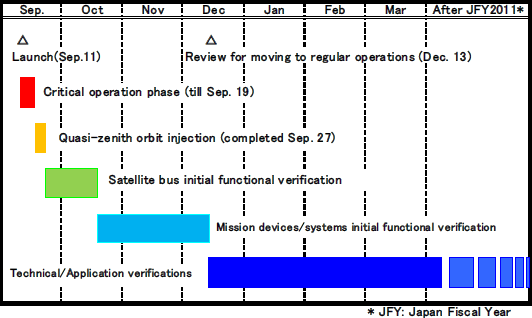First Quasi-Zenith Satellite MICHIBIKI
Technical Verification and Application Verification
Japan Aerospace Exploration Agency (JAXA)
Geospatial Information Authority of Japan (GSI)
National Institute of Advanced Industrial Science and Technology (AIST)
National Institute of Information and Communication Technology (NICT)
Electronic Navigation Research Institute (ENRI)
Satellite Positioning Research and Application Center (SPAC)
The Japan Aerospace Exploration Agency (JAXA), the Geospatial Information Authority of Japan (GSI), the National Institute of Advanced Industrial Science and Technology (AIST), the National Institute of Information and Communication Technology (NICT), the Electronic Navigation Research Institute (ENRI) and the Satellite Positioning Research and Application Center (SPAC) have conducted the initial functional verification of the First Quasi-Zenith Satellite "MICHIBIKI" for about three months. The MICHIBIKI was launched from the Tanegashima Space Center at 8:17 p.m. on September 11, 2010 (Japan Standard Time, all the following dates and time are JST,) and, during the initial verification, the satellite bus and onboard mission devices were confirmed as functioning.
As a result, all functions and performance were verified to be normal, thus JAXA moved the operation of MICHIBIKI to regular mode on December 13. Accordingly, we will begin technical and application verifications of the MICHIBIKI.
Each organization already started partial technical verifications when the health of their onboard device(s) and ground systems was confirmed. However, as JAXA switched all positioning signals to the standard code* at 11:48 a.m. on December 15, full-scale technical and application verifications will be performed by all organizations.
* Standard code:
Positioning signals were set to a non-standard code during the initial functional verification period; therefore, users were not able to capture signals. By setting them to the standard code, experimental users of the technical and application verifications can receive signals. Aside from the standard code, we also set up an "alert flag" which indicates that MICHIBIKI's positioning signals cannot be used (an alert condition,) thus general users cannot use MICHIBIKI's signals for their positioning calculation even if they acquire the signals. This "alert flag" will be removed after the quality and reliability of MICHIBIKI's signals are proved to satisfy the user interface specifications of the Quasi-Zenith Satellite System. (We plan to remove the alert flag in three to six months after starting the technical verification. We may temporarily remove it during the verification when experimental users require the removal for a test.)
|
|
